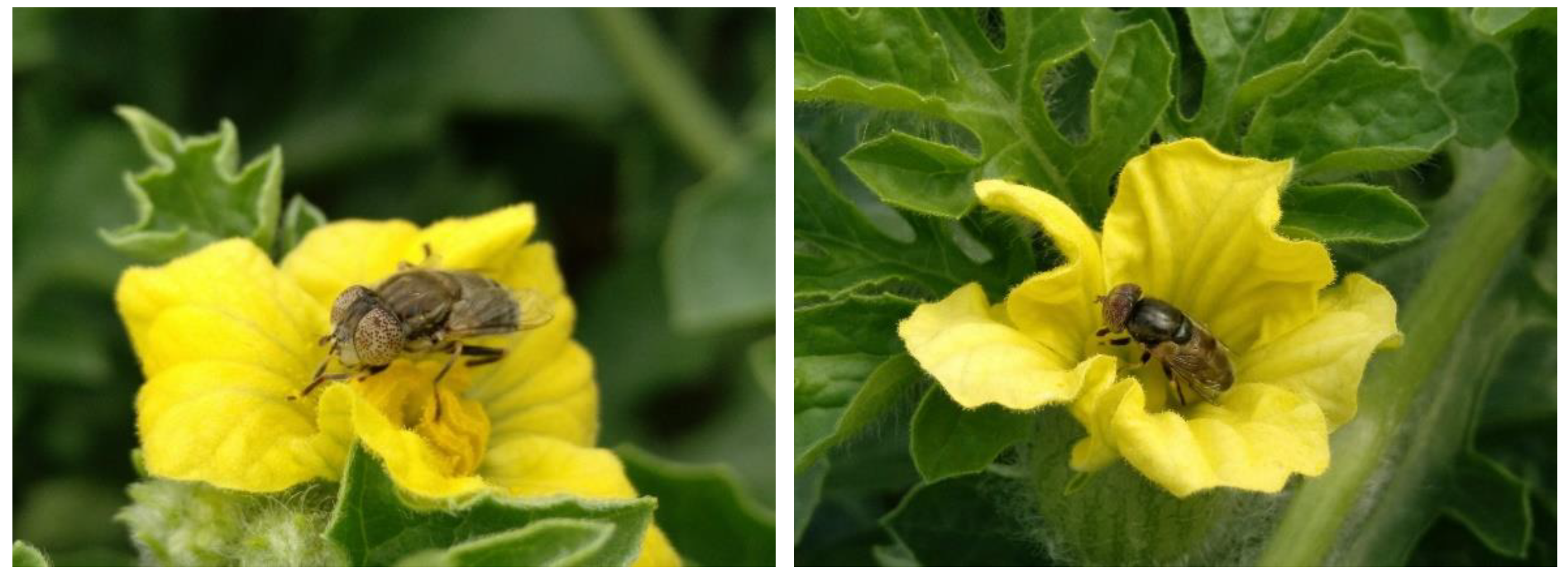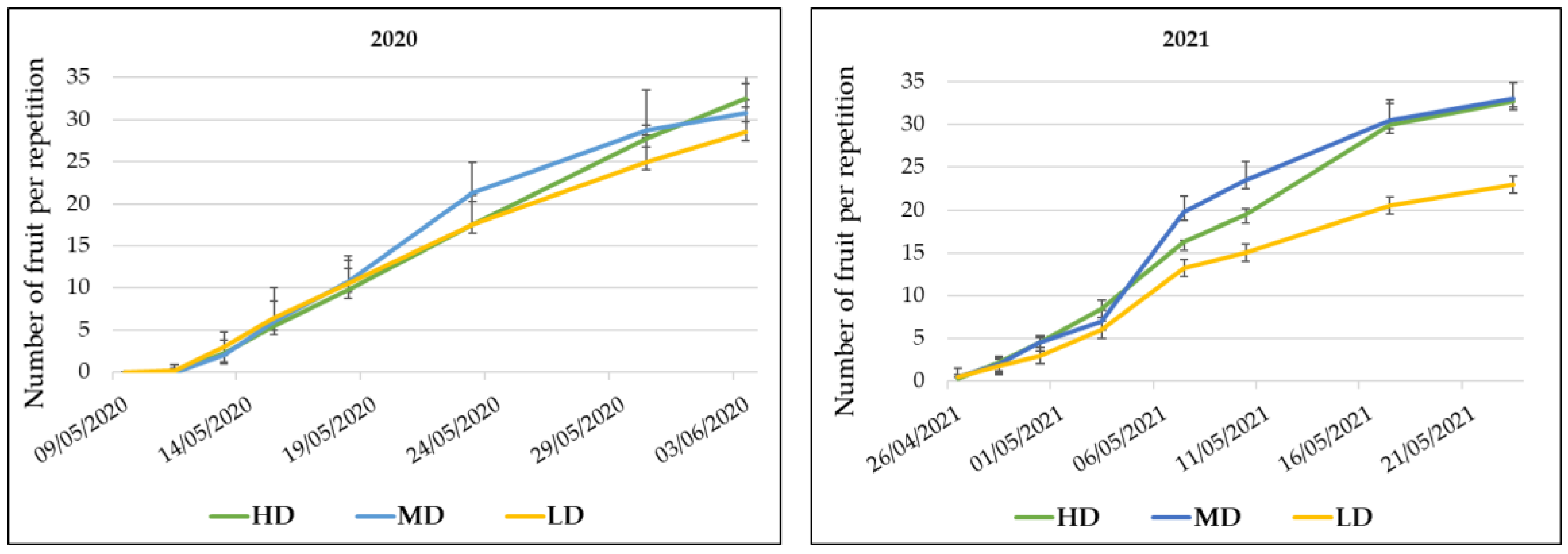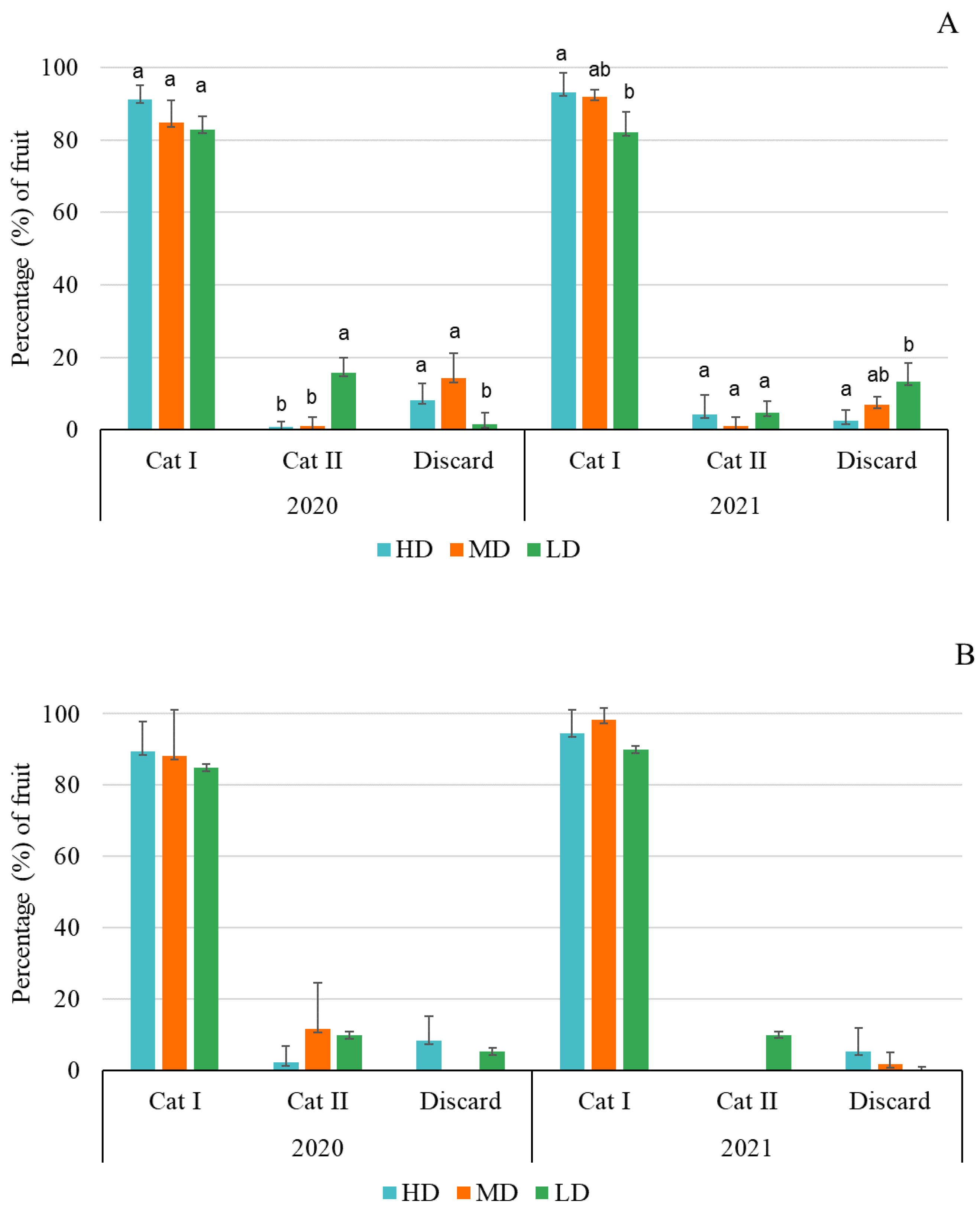Pollination Effectiveness of the Hoverfly Eristalinus aeneus (Scopoli, 1763) in Diploid and Triploid Associated Watermelon Crop
Abstract
Simple Summary
Abstract
1. Introduction
2. Materials and Methods
2.1. Field Experiment Location and Biological Material
2.2. Floral Visits
2.3. Pollen–Pistil Interaction
2.4. Fruit Set, Yield and Components
2.5. Statistical Analysis
3. Results
3.1. Floral Visits
3.2. Pollen–Pistil Interaction
3.3. Fruit Set, Yield and Components
4. Discussion
5. Conclusions
Supplementary Materials
Author Contributions
Funding
Data Availability Statement
Acknowledgments
Conflicts of Interest
References
- Schaffer, A.A.; Paris, H.S. Melons, squashes, and gourds. In Reference Module in Food Science; Elsevier: Amsterdam, The Netherlands, 2016; pp. 337–343. ISBN 978-0-08-100596-5. [Google Scholar] [CrossRef]
- FAOSTAT. Food and Agriculture Organization of the United Nations. Available online: http://www.fao.org/faostat/es/#data (accessed on 20 August 2022).
- Wijesinghe, S.A.E.C.; Evans, L.J.; Kirkland, L.; Rader, R. A global review of watermelon pollination biology and ecology: The increasing importance of seedless cultivars. Sci. Hortic. 2020, 271, 109493. [Google Scholar] [CrossRef]
- Castro-López, A.J.; García, E.; Caballero, T.M.; Linares, L.; Piñar, A.; Rivas, N.; Santillán, N.V.; Zienkiewicz, K.; Zienkiewicz, A.; Jamilena, M.; et al. Seedless watermelons: From the microscope to the table through the greenhouse. High School Res. Agric. Sci. Res. 2013, 3, 27–32. [Google Scholar]
- Free, J.B. Insect Pollination of Crops; Academic Press: London, UK, 1993; ISBN 0-12-266651-8. [Google Scholar]
- Delaplane, K.S.; Mayer, D.F. Crop Pollination by Bees; CABI Publishing Series: Wallingford, UK, 2000; ISBN 978-0-85199-783-4. [Google Scholar]
- Gallai, N.; Salles, J.-M.; Settele, J.; Vaissière, B.E. Economic valuation of the vulnerability of world agriculture confronted with pollinator decline. Ecol. Econ. 2009, 68, 810–821. [Google Scholar] [CrossRef]
- Adlerz, W.C. Honey bee visit numbers and watermelon pollination. J. Econ. Entomol. 1966, 59, 28–30. [Google Scholar] [CrossRef]
- Maynard, D.N. Triploid watermelons: A new version of an old crop. Am. Veg. Grow. 1989, 37, 42–43. [Google Scholar]
- Sawe, T.; Eldegard, K.; Totland, Ø.; Macrice, S.; Nielsen, A. Enhancing pollination is more effective than increased conventional agriculture inputs for improving watermelon yields. Ecol. Evol. 2020, 10, 5343–5353. [Google Scholar] [CrossRef]
- Dag, A.; Eisikowitch, D. The influence of hive location on honey bee foraging activity and fruit set in melons grown in plastic greenhouses. Apidologie 1995, 26, 511–519. [Google Scholar] [CrossRef]
- Westphal, C.; Steffan-Dewenter, I.; Tscharntke, T. Mass flowering crops enhance pollinator densities at a landscape scale. Ecol. Lett. 2003, 6, 961–965. [Google Scholar] [CrossRef]
- Dag, A. Bee pollination of crop plants under environmental conditions unique to enclosures. J. Apic. Res. 2008, 47, 162–165. [Google Scholar] [CrossRef]
- Rollin, O.; Bretagnolle, V.; Decourtye, A.; Aptel, J.; Michel, N.; Vaissière, B.E.; Henry, M. Differences of floral resource use between honey bees and wild bees in an intensive farming system. Agric. Ecosyst. Environ. 2013, 179, 78–86. [Google Scholar] [CrossRef]
- Evans, L.J.; Cutting, B.T.; Jochym, M.; Janke, M.A.; Felman, C.; Cross, S.; Jacob, M.; Goodwin, M. Netted crop covers reduce honey bee foraging activity and colony strength in a mass flowering crop. Ecol. Evol. 2019, 9, 5708–5719. [Google Scholar] [CrossRef] [PubMed]
- Descamps, C.; Jambrek, A.; Quinet, M.; Jacquemart, A.-L. Warm temperatures reduce flower attractiveness and bumble bee foraging. Insects 2021, 12, 493. [Google Scholar] [CrossRef] [PubMed]
- Kendall, L.K.; Evans, L.J.; Gee, M.; Smith, T.J.; Gagic, V.; Lobaton, J.D.; Hall, M.A.; Jones, J.; Kirkland, L.; Saunders, M.E.; et al. The effect of protective covers on pollinator health and pollination service delivery. Agric. Ecosyst. Environ. 2021, 319, 107556. [Google Scholar] [CrossRef]
- Petropoulou, Y.; Georgiou, O.; Psaras, G.; Manetas, Y. Improved flower advertisement, pollinator rewards and seed yield by enhanced UV-B radiation in the mediterranean annual Malcolmia maritima. New Phytol. 2001, 152, 85–90. [Google Scholar] [CrossRef] [PubMed]
- Spaethe, J.; Briscoe, A.D. Molecular characterization and expression of the UV opsin in bumble bees: Three ommatidial subtypes in the retina and a new photoreceptor organ in the lamina. J. Exp. Biol. 2005, 208, 2347–2361. [Google Scholar] [CrossRef]
- Blacquière, T.; Aa-Furnée, J.; Cornelissen, B.; Donders, J. Behaviour of honey bees and bumble bees beneath three different greenhouse claddings. Proc. Neth. Entomol. Soc. Meet. 2006, 17, 93–102. [Google Scholar]
- Guerra-Sanz, J.M.; Roldán-Serrano, A. Influence of honey bees brood pheromone on the production of triploid watermelon. In Cucurbitaceae, Proceedings of the IXth EUCARPIA Meeting on Genetics and Breeding of Cucurbitaceae, Avignon, France, 21–24 May 2008; Institut National de la Recherche Agronomique (INRA): Paris, France, 2008; pp. 385–390. [Google Scholar]
- Huitrón, M.V.; Diaz, M.; Diánez, F.; Camacho, F.; Valverde, A. Effect of 2,4-D and CPPU on triploid watermelon production and quality. HortScience 2007, 42, 559–564. [Google Scholar] [CrossRef]
- Stanghellini, M.S.; Ambrose, J.T.; Schultheis, J.R. Seed production in watermelon: A comparison between two commercially available pollinators. HortScience 1998, 33, 28–30. [Google Scholar] [CrossRef]
- Njoroge, G.N.; Gemmill, B.; Bussmann, R.; Newton, L.E.; Ngumi, V.M. Diversity and efficiency of wild pollinators of watermelon (Citrullus lanatus (Thunb.) Mansf.) at Yatta (Kenya). J. Appl. Hortic. 2010, 12, 35–41. [Google Scholar] [CrossRef]
- Bomfim, I.G.A.; de Melo Bezerra, A.D.; Nunes, A.C.; de Aragào, F.A.S.; Freitas, B.M. Adaptive and foraging behavior of two stingless bee species in greenhouse mini watermelon pollination. Sociobiology 2014, 61, 502–509. [Google Scholar] [CrossRef]
- Marchese, J.I.; Johnson, G.J.; Delaney, D.A. Exposure effects on the productivity of commercial Bombus impatiens (Hymenoptera: Apidae) quads during bloom in watermelon fields. J. Econ. Entomol. 2015, 108, 1810–1817. [Google Scholar] [CrossRef] [PubMed]
- Garantonakis, N.; Varikou, K.; Birouraki, A.; Edwards, M.; Kalliakaki, V.; Andrinopoulos, F. Comparing the pollination services of honey bees and wild bees in a watermelon field. Sci. Hortic. 2016, 204, 138–144. [Google Scholar] [CrossRef]
- Pisanty, G.; Afik, O.; Wajnberg, E.; Mandelik, Y. Watermelon pollinators exhibit complementarity in both visitation rate and single-visit pollination efficiency. J. Appl. Ecol. 2016, 53, 360–370. [Google Scholar] [CrossRef]
- Campbell, J.W.; Daniels, J.C.; Ellis, J.D. Fruit set and single visit stigma pollen deposition by managed bumble bees and wild bees in Citrullus lanatus (Cucurbitales: Cucurbitaceae). J. Econ. Entomol. 2018, 111, 989–992. [Google Scholar] [CrossRef] [PubMed]
- Campbell, J.W.; Stanley-Stahr, C.; Bammer, M.; Daniels, J.C.; Ellis, J.D. Contribution of bees and other pollinators to watermelon (Citrullus Lanatus Thunb.) pollination. J. Apic. Res. 2019, 58, 597–603. [Google Scholar] [CrossRef]
- Azo’o, E.M.; Bissou, W.B.; Tchuenguem, F.F.N. Comparing the foraging behaviour and pollination efficiency of Apis mellifera with Xylocopa olivacea (Apidae: Hymenoptera) on Citrullus lanatus flowers. J. Appl. Hortic. 2020, 22, 18–23. [Google Scholar] [CrossRef]
- Kremen, C.; Williams, N.M.; Thorp, R.W. Crop pollination from native bees at risk from agricultural intensification. Proc. Natl. Acad. Sci. USA 2002, 99, 16812–16816. [Google Scholar] [CrossRef]
- Njoroge, G.N.; Gemmill, B.; Bussmann, R.; Newton, L.E.; Ngumi, V.W. Pollination ecology of Citrullus lanatus at Yatta, Kenya. Int. J. Trop. Insect Sci. 2004, 24, 73–77. [Google Scholar] [CrossRef]
- Taha, E.-K.; Bayoumi, Y. The value of honey bees (Apis mellifera, L.) as pollinators of summer seed watermelon (Citrullus lanatus Colothynthoides L.) in Egypt. Acta Biol. Szeged. 2009, 53, 33–37. [Google Scholar]
- Rader, R.; Bartomeus, I.; Garibaldi, L.A.; Garratt, M.P.D.; Howlett, B.G.; Winfree, R.; Cunningham, S.A.; Mayfield, M.M.; Arthur, A.D.; Andersson, G.K.S.; et al. Non-bee insects are important contributors to global crop pollination. Proc. Natl. Acad. Sci. USA 2016, 113, 146–151. [Google Scholar] [CrossRef]
- Layek, U.; Kundu, A.; Bisui, S.; Karmakar, P. Impact of managed stingless bee and western honey bee colonies on native pollinators and yield of watermelon: A comparative study. Ann. Agric. Sci. 2021, 66, 38–45. [Google Scholar] [CrossRef]
- Gilbert, F.S. Foraging Ecology of Hoverflies: Morphology of the mouthparts in relation to feeding on nectar and pollen in some common urban species. Ecol. Entomol. 1981, 6, 245–262. [Google Scholar] [CrossRef]
- Kevan, P.; Baker, H. Insects as flower visitors and pollinators. Annu. Rev. Entomol. 1983, 28, 407–453. [Google Scholar] [CrossRef]
- Klecka, J.; Hadrava, J.; Biella, P.; Akter, A. Flower visitation by hoverflies (Diptera: Syrphidae) in a temperate plant-pollinator network. PeerJ 2018, 6, e6025. [Google Scholar] [CrossRef]
- Sánchez, M.; Velásquez, Y.; González, M.; Cuevas, J. Hoverfly pollination enhances yield and fruit quality in mango under protected cultivation. Sci. Hortic. 2022, 304, 111320. [Google Scholar] [CrossRef]
- Sánchez, M.; Belliure, B.; Montserrat, M.; Gil, J.; Velásquez, Y. Pollination by the hoverfly Eristalinus aeneus (Diptera: Syrphidae) in two hybrid seed crops: Celery and fennel (Apiaceae). J. Agric. Sci. 2022, 160, 194–206. [Google Scholar] [CrossRef]
- Martin, F.W. Staining and observing pollen tubes in the style by means of fluorescence. Stain Technol. 1959, 34, 125–128. [Google Scholar] [CrossRef]
- de Andalucía, J. Observatorio de Precios y Mercados. Consejería de Agricultura, Pesca y Desarrollo Rural. Available online: https://www.juntadeandalucia.es/agriculturaypesca/observatorio/servlet/FrontController?ec=default (accessed on 16 September 2022).
- Reche, J. Cultivo Intensivo de la Sandía; Hojas Divulgadoras; Ministerio de Agricultura, Pesca y Alimentación: Madrid, Spain, 1994; ISBN 84-491-0464-5. [Google Scholar]
- Ministerio de Agricultura, Pesca y Alimentación. ESYRCE. Available online: https://www.mapa.gob.es/es/estadistica/temas/estadisticas-agrarias/agricultura/esyrce/ (accessed on 10 December 2021).
- Fiacchino, D.C.; Walters, S.A. Influence of diploid pollinizer frequencies on triploid watermelon quality and yields. HortTechnology 2003, 13, 58–61. [Google Scholar] [CrossRef]
- Freeman, J.H.; Miller, G.A.; Olson, S.M.; Stall, W.M. Diploid watermelon pollenizer cultivars differ with respect to triploid watermelon yield. HortTechnology 2007, 17, 518–522. [Google Scholar] [CrossRef]
- Akre, R.D.; Reed, H.C. Ants, wasps, and bees (Hymenoptera). In Medical and Veterinary Entomology; Mullen, G., Durden, L., Eds.; Academic Press: San Diego, CA, USA, 2002; pp. 383–409. ISBN 978-0-12-510451-7. [Google Scholar]
- Harder, L.D.; Barrett, S.C.H. Pollen dispersal and mating patterns in animal-pollinated plants. In Floral Biology: Studies on Floral Evolution in Animal-Pollinated Plants; Lloyd, D.G., Barrett, S.C.H., Eds.; Chapman & Hall: New York, NY, USA, 1996; pp. 140–190. [Google Scholar]
- Sánchez, M.; Velásquez, Y.; González, M.; Cuevas, J. Activity and foraging behaviour of the hoverfly Eristalinus aeneus (Scopoli, 1763) in protected cultivation of mango (Mangifera indica L.). Bull. Entomol. Res. 2022, 112, 101–109. [Google Scholar] [CrossRef]
- Wolf, S.; Lensky, Y.; Paldi, N. Genetic variability in flower attractiveness to honey bees (Apis mellifera L.) within the genus Citrullus. HortScience 1999, 34, 860–863. [Google Scholar] [CrossRef]
- Kiill, L.; Siqueira, K.; Coelho, M.; Silva, T.; Gama, D.; Araújo, D.C.S.; Pereira, J. Frequency and foraging behavior of Apis mellifera in two melon hybrids in Juazeiro, state of Bahia, Brazil. An. Acad. Brasil. Ci. 2014, 86, 2049–2055. [Google Scholar] [CrossRef] [PubMed][Green Version]
- Stanghellini, M.S.; Ambrose, J.T.; Schultheis, J.R. The effects of honey bee and bumble bee pollination on fruit set and abortion of cucumber and watermelon. Am. Bee J. 1997, 137, 386–391. [Google Scholar]
- Walters, S.A. Influence of honey bee pollination on triploid watermelon fruit set and quality. HortScience 2005, 40, 1118C. [Google Scholar] [CrossRef]
- Winfree, R.; Williams, N.M.; Dushoff, J.; Kremen, C. Native bees provide insurance against ongoing honey bee losses. Ecol. Lett. 2007, 10, 1105–1113. [Google Scholar] [CrossRef]
- Munyuli, T. Influence of functional traits on foraging behaviour and pollination efficiency of wild social and solitary bees visiting coffee (Coffea canephora) flowers in Uganda. Grana 2014, 53, 69–89. [Google Scholar] [CrossRef]
- Araújo, D.; Siqueira, K.; Duarte, P.; Silva, N. Comportamento de forrageamento de Apis mellifera na melancieira (Citrullus lanatus) no município de Juazeiro, BA. Rev. Verde 2014, 9, 59–67. [Google Scholar]
- Mann, L.K. Fruit shape of watermelon as affected by placement of pollen on stigma. Bot. Gaz. 1943, 105, 257–262. [Google Scholar] [CrossRef]
- Stebbins, G.L. Adaptive radiation of reproductive characteristics in angiosperms I. Pollination mechanisms. Annu. Rev. Ecol. Evol. Syst. 1970, 1, 307–326. [Google Scholar] [CrossRef]
- Van der Niet, T.; Peakall, R.; Johnson, S.D. Pollinator-driven ecological speciation in plants: New evidence and future perspectives. Ann. Bot. 2014, 113, 199–212. [Google Scholar] [CrossRef]





| Parameters | Variable | SS | Df | F-Value | Pr (>F) |
|---|---|---|---|---|---|
| Number of visits | Release density | 13.99 | 2 | 108.361 | <0.0001 *** |
| Type of flower | 0.32 | 1 | 4.971 | 0.0274 * | |
| Residuals | 9.04 | 140 | |||
| Duration of visits | Release density | 3.41 | 2 | 0.346 | 0.7079 |
| Type of flower | 3.84 | 1 | 0.779 | 0.3779 | |
| Residuals | 2222.22 | 451 |
| Treatments | Number of Visits (n) | Duration of Visits (s) | ||
|---|---|---|---|---|
| Pistillate Flower | Staminate Flower | Pistillate Flower | Staminate Flower | |
| HD | 3.92 ± 0.18 a | 4.63 ± 0.25 a | 40.51 ± 2.54 | 42.63 ± 3.24 |
| MD | 3.33 ± 0.18 b | 3.38 ± 0.17 b | 49.74 ± 4.29 | 42.08 ± 4.04 |
| LD | 1.63 ± 0.13 c | 1.92 ± 0.16 c | 45.28 ± 4.84 | 40.67 ± 4.76 |
| Treatment | Year 2020 | Year 2021 |
|---|---|---|
| HD | 904.71 ± 109.10 a (290–1819) | 716.95 ± 24.32 a (233–1804) |
| MD | 811.88 ± 57.05 a (36–1763) | 555.56 ± 34.25 a (9–1167) |
| LD | 439.38 ± 64.16 b (36–1101) | 348.30 ± 78.39 b (0–1278) |
| Parameters | Treatment | Year 2020 | Year 2021 | ||
|---|---|---|---|---|---|
| Diploid | Triploid | Diploid | Triploid | ||
| Fruit per plant (num) | HD | 6.17 ± 0.33 a | 4.89 ± 0.77 a | 7.25 ± 0.83 a | 3.71 ± 0.22 a |
| MD | 5.38 ± 0.43 a | 3.67 ± 0.31 ab | 6.25 ± 0.59 a | 3.54 ± 0.14 a | |
| LD | 6.50 ± 1.14 a | 2.79 ± 0.36 b | 5.00 ± 0.98 a | 2.71 ± 0.22 b | |
| Fruit weight (kg) | HD | 3.06 ± 0.38 a | 5.24 ± 0.20 a | 2.81 ± 0.21 a | 5.50 ± 0.23 a |
| MD | 3.02 ± 0.09 a | 5.02 ± 0.35 a | 2.91 ± 0.10 a | 4.89 ± 0.22 ab | |
| LD | 2.99 ± 0.21 a | 5.00 ± 0.22 a | 2.92 ± 0.29 a | 4.18 ± 0.37 b | |
| Yield (kg/m2) | HD | 4.63 ± 0.49 a | 5.93 ± 0.72 a | 4.99 ± 0.35 a | 5.07 ± 0.26 a |
| MD | 4.07 ± 0.37 a | 4.67 ± 0.64 ab | 4.51 ± 0.33 a | 4.31 ± 0.05 a | |
| LD | 4.77 ± 0.76 a | 3.45 ± 0.33 b | 3.84 ± 1.03 a | 2.82 ± 0.30 b | |
| Parameters | Treatment | Year 2020 | Year 2021 | ||
|---|---|---|---|---|---|
| Diploid | Triploid | Diploid | Triploid | ||
| Number of seeds per ¼ fruit | HD | 346.75 ± 18.25 a | 311.75 ± 13.94 a | 424.50 ± 29.24 a | 434.50 ± 19.21 a |
| MD | 342.00 ± 12.89 a | 304.75 ± 9.68 a | 403.00 ± 19.00 a | 400.50 ± 23.29 a | |
| LD | 314.75 ± 4.82 a | 243.00 ± 9.31 b | 350.00 ± 13.46 a | 289.00 ± 20.17 b | |
| °Brix | HD | 9.17 ± 0.32 a | 11.09 ± 0.17 a | 11.62 ± 0.34 a | 13.08 ± 0.40 a |
| MD | 9.45 ± 0.36 a | 11.49 ± 0.28 a | 11.90 ± 0.19 a | 12.75 ± 0.21 a | |
| LD | 9.42 ± 0.74 a | 11.25 ± 0.29 a | 11.89 ± 0.39 a | 12.43 ± 0.26 a | |
| Parameters | Treatment | Year 2020 | Year 2021 | ||||
|---|---|---|---|---|---|---|---|
| Diploid | Triploid | Total 2020 | Diploid | Triploid | Total 2021 | ||
| Yield (t/ha) | HD | 15.25 | 39.44 | 54.69 | 16.12 | 33.57 | 49.69 |
| MD | 13.55 | 30.13 | 43.68 | 14.83 | 28.11 | 42.94 | |
| LD | 15.65 | 22.96 | 38.61 | 12.79 | 17.91 | 30.70 | |
| Economic yield (EUR/ha) | HD | 2877.89 | 12,118.11 | 14,996.00 | 2740.44 | 8232.24 | 10,972.69 |
| MD | 2489.82 | 9259.15 | 11,748.97 | 2520.88 | 7001.28 | 9522.16 | |
| LD | 2880.50 | 6604.32 | 9484.82 | 2163.24 | 4356.88 | 6520.13 | |
Publisher’s Note: MDPI stays neutral with regard to jurisdictional claims in published maps and institutional affiliations. |
© 2022 by the authors. Licensee MDPI, Basel, Switzerland. This article is an open access article distributed under the terms and conditions of the Creative Commons Attribution (CC BY) license (https://creativecommons.org/licenses/by/4.0/).
Share and Cite
Sánchez, M.; Velásquez, Y.; González, M.; Cuevas, J. Pollination Effectiveness of the Hoverfly Eristalinus aeneus (Scopoli, 1763) in Diploid and Triploid Associated Watermelon Crop. Insects 2022, 13, 1021. https://doi.org/10.3390/insects13111021
Sánchez M, Velásquez Y, González M, Cuevas J. Pollination Effectiveness of the Hoverfly Eristalinus aeneus (Scopoli, 1763) in Diploid and Triploid Associated Watermelon Crop. Insects. 2022; 13(11):1021. https://doi.org/10.3390/insects13111021
Chicago/Turabian StyleSánchez, Manuela, Yelitza Velásquez, Mónica González, and Julián Cuevas. 2022. "Pollination Effectiveness of the Hoverfly Eristalinus aeneus (Scopoli, 1763) in Diploid and Triploid Associated Watermelon Crop" Insects 13, no. 11: 1021. https://doi.org/10.3390/insects13111021
APA StyleSánchez, M., Velásquez, Y., González, M., & Cuevas, J. (2022). Pollination Effectiveness of the Hoverfly Eristalinus aeneus (Scopoli, 1763) in Diploid and Triploid Associated Watermelon Crop. Insects, 13(11), 1021. https://doi.org/10.3390/insects13111021







